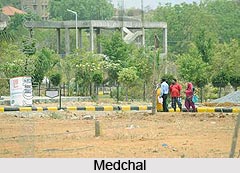 Medchal is a northern suburb of Hyderabad, the common capital of both Telangana and Andhra Pradesh. It used be a suburban village and one of the largest mandals in Rangareddy district of Telangana. Earlier, it was known as Medi (Fig) Chelama (spring), but later came to be called as Medchal. The meaning of Medchal is "Town of Glory". It has an average elevation of 577 meters. The official language of this village is Telugu.
Medchal is a northern suburb of Hyderabad, the common capital of both Telangana and Andhra Pradesh. It used be a suburban village and one of the largest mandals in Rangareddy district of Telangana. Earlier, it was known as Medi (Fig) Chelama (spring), but later came to be called as Medchal. The meaning of Medchal is "Town of Glory". It has an average elevation of 577 meters. The official language of this village is Telugu.
Demographics of Medchal
According to census of 2011, the total population of Medchal is 35611 out of which males are 18017 and females are 17594. Among them literate people are 25007. In Medchal, there are 4621 children below 6 years of age.
Commercial Area of Medchal
There are few commercial areas in this place like MediCiti Institute of Medical Sciences located at Ghanpur village in Medchal mandal; Mediciti Hospital attached to this institution; Shantha Biotechnics (P) Ltd., located at Athvelly village in Medchal mandal and Ultra Tile (P) Limited., located in Kistapur, Medchal mandal.
Panchayats of Medchal
There are eighteen village panchayats in Medchal mandal including Athvelly, Bandamadharam, Dabilpur, Girmapur, Goudavelly, Gundlapochampalle, Kandlakoya, Medchal, Muneerabad, Nuthankal, Pudoor, Raja Bollaram, Ravalkole, Rayalapur, Somaram, Sreerangavaram, Yadaram, and Yellampet.
Attractions of Medchal
Medchal is known for certain historical monuments. This place was once resort for Nizams who constructed some beautiful mansion here. In addition to these, Medchal is home to Sri Sri Sri GadiMaisamma temple and Ramalingeshwara temple. These temples are nestled at a height of 61 meters on hillock. They are believed to be constructed by Kakatiyas. In Medchal, there is also a mosque built during the time of Quli Qutub Shah. This village is also known for saint Jaffer sahab who served the people of this village as well as other areas.
Connectivity to Medchal
Medchal is well connected via railway and roadway. The closest railheads are Medchal railway station and Dabilpur railway station. One can also avail train services from near by town of Quthbullapur. Sanat Nagar railway station and Fatehnagar Bridge railway station are the nearest railheads to Quthbullapur.
In terms of road connectivity, one can avail transport services from Quthbullapur as it is the nearest town to Medchal. Quthbullapur is 20 km from Medchal.



















